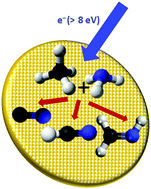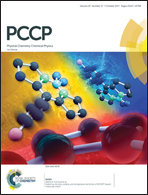Electron induced reactions in condensed mixtures of methane and ammonia
Abstract
We demonstrate the efficient formation of carbon–nitrogen bonds starting from CH4 and NH3 on a metal surface at cryogenic temperatures. Electrons in the energy range of 1–90 eV are used to initiate chemical reactions in mixed molecular films of CH4 and NH3 at ∼15 K, and the products are detected by performing temperature programmed desorption (TPD). Extensive dehydrogenation occurs at all energies giving the products CH2NH and HCN in preference to CH3NH2. This is likely to do with the energetics of the reactions and the subsequent stability of these species in the condensed film. Thermal processing of the irradiated mixture favours dehydrogenation as indicated by the results of using different desorption rates. Electron impact excitation and subsequent dissociation into radicals is the reaction-initiating step rather than ionization of CH4 and NH3, as inferred from the yield of products as a function of electron energy. This could give insight into the important catalytic process of the industrial scale synthesis of HCN from CH4 and NH3 over Pt. This may also be a relevant pathway in the astrochemical environment where CN and HCN are abundant and low-energy electrons are found ubiquitously.



 Please wait while we load your content...
Please wait while we load your content...